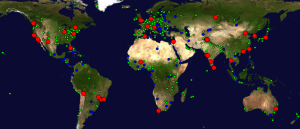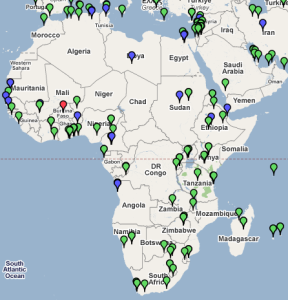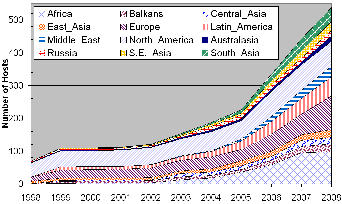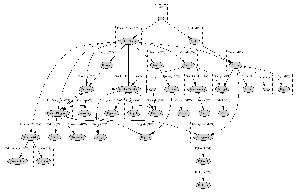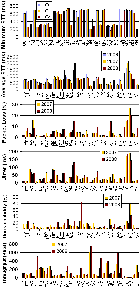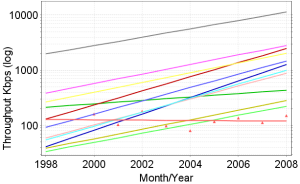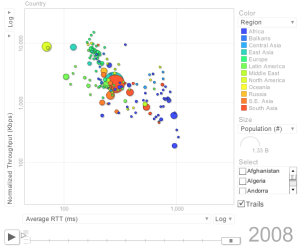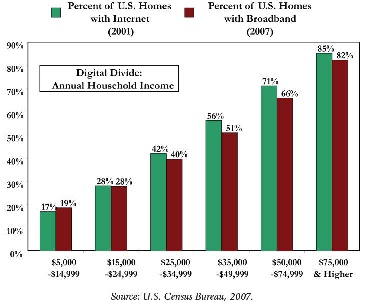PingER
Submarine Fibre Links Connecting Africa
(c) manypossibilities.net - current |
|---|
|
Routing to and within Sub-Saharan Africa
Generated by: PingER Route Visualizer
...
As seen from UNSW, | As seen from KHU | As seen from ACMESECURITY |
|---|---|---|
|
|
|
PingER Performance Metrics
MinRTT, AvgRTT, Packet Loss, | Derived Throughput (Kbps) |
|---|---|
| |
Selected PingER Visualizations
Motion Chart | Motion Chart |
|---|---|
|
|
Recommendations
OECD Information Technology Outlook 2008: Highlights
| Panel |
|---|
Top ten ICT policy priorities, 20081 Government on line, government as model users |
IHY, eGY, IST Recommendations
- Recognize: can't fix all ills for all people over night.
- Identify focus areas:
- educate teachers & students, attract research (reverse brain drain)
- applications: e.g. education, telemedicine, distance learning ...
- Find energetic leaders from country/region
- Engage policy makers for science, technology, education ...:
- Encourage ICT development, Internet adoption
- Collaborate between institutions, regions to increase leverage
- Form partnerships with vendors & providers:
- Drive market penetration, create demand, long term investments...
- Get support: funding agencies, diaspora, organizations like IHY, eGY, ICTP, professional societies ...
- Make & use measurements to illustrate case for improvement
- Acknowledge need for new business models appropriate for region
News
Orange to link Madagascar to broadband internet via a new submarine fibre optic cable Paris, March 26, 2008, from Mike Jensen
France Telecom & Orange plan to install a submarine fibre optic cable
providing Madagascar with broadband internet. Known as Lion, the 1,800 km cable will connect Madagascar with the region's existing Sat3-Wasc-Safe cable.
...
| Panel |
|---|
Perhaps this is good news for Madagascar, but too early to tell...as it stands now they'll still have to connect upstream to the costly and unreliable SAFE..but there is also rumour that TEAMS will head down to Mauritius, so if that happens then there will be much better upstream bandwidth for madagascar/mauritius/reunion... so yes, SAT3/SAFE is still run on old business model and limited capacity, hopefully it will finally get some real competition! |
h3 SEACOM to launch Africa undersea cable June 2009
Reuters, Thursday August 14 2008
JOHANNESBURG, Aug 14 (Reuters) - Mauritius-registered private equity venture SEACOM said on Thursday a fibre optic undersea cable linking east Africa to Europe and Asia would be launched in June 2009, in time for the 2010 soccer World Cup.
The company said in a statement it would start laying the $650 million cable, which is needed to provide high-speed Internet access and spur investment, in October this year.
The 15,000 km cable will wind around the east of the continent between South Africa and Egypt, then on to Mumbai in India and Marseille in France. The group will start connecting sections of the cable in April 2009.
"The team is also trying to expedite the construction in an attempt to assist with the broadcasting requirements of the FIFA Confederations Cup scheduled for June 2009," SEACOM said.
The cable will provide 1.28 terabits per second of broadband capacity to enable high definition TV and provide inexpensive bandwidth.
SEACOM said last year investors in the venture included an arm of the Aga Khan Fund for Economic Development, Venfin Ltd. and Herakles Telecom LLC, each with a 25 percent stake, and Convergence Partners with a 12.5 percent shareholding.
The Shanduka Group, owned by South African black business tycoon Cyril Rhamaphosa, holds the remaining 12.5 percent.
Nedbank Capital, a division of Nedbank and Investec Bank are funding the project.
South Africa's second telephone network operator, Neotel NEO.UL, which is competing with former monopoly Telkom has secured the rights to control the cable's use in South Africa.
South Africa has only one cable linking it to the rest of the world and this was controlled by Telkom until Sept. 2007. (Reporting by Gugulakhe Lourie; editing by Tony Austin)
Google & Satellite coverrage (September 2008)
Google announced this week that it was involved in a radical new plan to bring internet access to the majority of the developing world.
...
The report says the major reason for this is the lack of high-quality backbone infrastructure that would allow for affordable mass-market broadband access.
EU-AU Partnership (October 6, 2008)
The African Union Commission and the European Commission have issued a joint statement on the implementation of the EU-AU partnership for science, information society and space.
...
The statement can be downloaded at http://www.euroafrica-ict.org/downloads/EU-AU_Joint_Statement_Final_EN_EU.pdf.
Africa's first communications satellite fails (Science and Development Network (November 17, 2008)
By Adole Hassan
ABUJA Africa's first communications satellite has suffered an energy failure just 18 months after its launch.
...
Zaku told SciDev.Net that Internet service providers in Nigeria and telecommunications companies who were using the satellite would be moved to other satellites if engineers confirm that it is unfixable.
Other Digital Divides
Economic Digital Divide
As seen below in the graph (from Down Payment on Our Digital Future ) of percent of US homes with the Internet in 2001 and Broadband in 2007 there is a economic digital divide.
A Typology of Information and Communication Technology Users
This sorts Americans into 10 distinct roups of uses of communication and information technology. It shows that:
| Panel |
|---|
Some 15% of Americans have neither a cell phone nor internet access. They tend to be in their mid-60s, nearly three-fifths are women, and they have low levels of income and education. Although a few have computers or digital cameras, these items seem to be about moving digital information within the household – for example, using the computer to display digital photos that they take or others physically bring into the house. |
Presentations
- "The Strategic importance and impact of e-infrastrucures for Science, Society and Economy in Europe and neighbouring Southern Countries", Robert Klapisch, EUMED 2008, Amman, Jordan 2008
- Digital Divide in Sub-Saharan African Universities: recommendations and monitoring, by B. Barry, M. Petitdidier, L. Cottrell, C. Barton for the IST-Africa conference and exhibition, May 07-09, 2008 Windhoek, Namibia.
